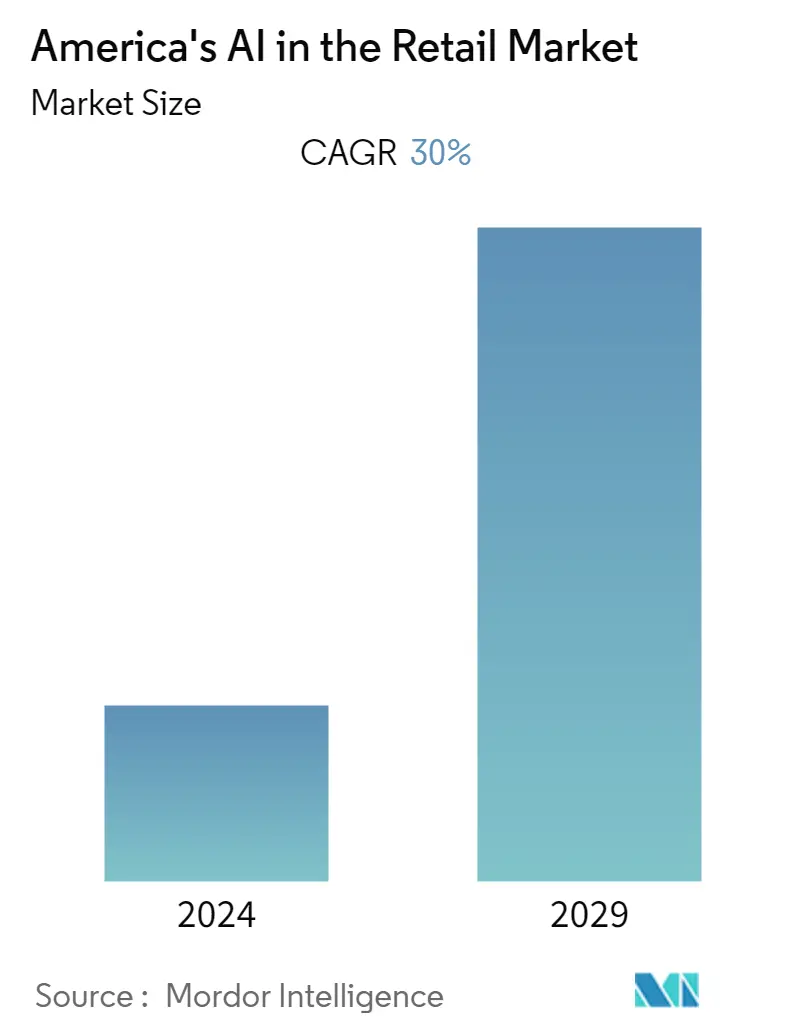Market Size of America's AI in the Retail Industry

| Study Period | 2019 - 2029 |
| Base Year For Estimation | 2023 |
| Forecast Data Period | 2024 - 2029 |
| Historical Data Period | 2019 - 2022 |
| CAGR | 30.00 % |
| Market Concentration | High |
Major Players
*Disclaimer: Major Players sorted in no particular order |
America AI in the Retail Market Analysis
America's AI in the retail market is expected to register a CAGR of 30% during the forecast period, 2021 - 2026. Artificial intelligence (AI) is driving faster business decisions in marketing, e-commerce, product management, and other areas of the business by decreasing the gap from insights to action. According to the United States Department of Commerce, retail sales in the United States are expected to reach USD 5.99 trillion in 2023.
- North America is expected to dominate the market with the largest market share, mainly because of the presence of several developed economies, such as the United States and Canada, focusing on enhancing the existing solutions in the retail space. North America hosts the primary AI solution providers and is an early adopter of AI technology.
- Machine learning and deep learning technologies are expected to have the most significant market shares, during the forecast period. Organizations in the retail industry are using machine learning and deep learning technology to offer a more personalized experience to the end-users, as well as to provide an interactive environment to them. According to a study by IBM, the adoption of AI in the retail and consumer products industries is projected to leap from 40% of companies today to more than 80% in three years.
- The use of artificial intelligence in retail spans across every aspect of the industry. Whether the goal is to optimize the supply chain, use existing data to increase conversion, or customize shopping experiences with predictive modelling and micro-targeting or pricing, AI can help meet these challenges in the retail space.
- The retailers in the United States are adopting AI for security and efficiency in the store. The security breaches in stealing the consumer data are growing in the region, thus pushing the companies to use AI as the solutions. For instance, in 2019, Adidas confirmed unauthorized third party access to customer data on the United States website.
- According to SOTI, online retail sales in the United States is projected to surpass USD 740 billion in 2023 as people in the region are more comfortable using an alternative delivery option of goods. Thus, AI plays a crucial role in shaping online retail sales in the country by streamlining the processes.
- Latin America is slowly adopting the AI in retail due to different countries having different taxation systems, even between countries in the same regionAmerica's AI in the retail market is expected to register a CAGR of 30% during the forecast period, 2020-2025. Artificial intelligence (AI) is driving faster business decisions in marketing, e-commerce, product management, and other areas of the business by decreasing the gap from insights to action. According to the United States Department of Commerce, retail sales in the United States are expected to reach USD 5.99 trillion in 2023.
- North America is expected to dominate the market with the largest market share, mainly because of the presence of several developed economies, such as the United States and Canada, focusing on enhancing the existing solutions in the retail space. North America hosts the primary AI solution providers and is an early adopter of AI technology.
- Machine learning and deep learning technologies are expected to have the most significant market shares during the forecast period. Organizations in the retail industry are using machine learning and deep learning technology to offer a more personalized experience to the end-users, as well as to provide an interactive environment to them. According to a study by IBM, the adoption of AI in the retail and consumer products industries is projected to leap from 40% of companies today to more than 80% in three years.
- The use of artificial intelligence in the retail sector spans across every aspect of the industry. Whether the goal is to optimize the supply chain, use existing data to increase conversion, or customize shopping experiences with predictive modeling and micro-targeting or pricing, AI can help meet these challenges in the retail space.
- The retailers in the United States are adopting AI for security and efficiency in the store. The security breaches in stealing the consumer data are growing in the region, thus pushing the companies to use AI as the solutions. For instance, in 2019, Adidas confirmed unauthorized third party access to customer data on the United States website.
- According to SOTI, online retail sales in the United States is projected to surpass USD 740 billion in 2023 as people in the region are more comfortable using an alternative delivery option of goods. Thus, AI plays a crucial role in shaping online retail sales in the country by streamlining the processes.
- Latin America is slowly adopting AI in retail due to varying taxation systems, even between countries belonging to the same region that is often fraught with duties. Additionally, the slow adoption of smartphones is posing a hurdle for companies to penetrate with AI in the retail ecosystem. According to GSMA, the mobile penetration rate in Latin America was only 67%, in 2018.
- With the recent outburst of COVID-19, the retail industry is facing significant supply chain disruption in the region and other problems. However, the usage of AI can help deliver goods to the customer by making a centralized AI unit that stores all the data about demand generation. It can also use a drone that uses the AI algorithm to deliver the most vital and essential supplies, such as medicine and protective gear, among others, to the consumer. are often fraught with duties, and slow adoption of smartphones are making difficulties for companies to penetrate with AI in the retail ecosystem. According to GSMA, the mobile penetration rate in Latin America was only 67% in 2018.
- With recent outburst of COVID-19, the retail industry is facing significant supply chain disruption in the region and other problems. But using the technology of AI, it can deliver the goods to the customer, by making a centralized AI unit that stores all the data pertaining to demand generation and can use a drone that uses AI algorithm to deliver the most vital and essential supplies such as medicine and protective gears and others to the consumer.
America AI in the Retail Industry Segmentation
The application of artificial intelligence (AI), Big Data, and analytics will push the business access toward a data-driven model by expanding the types of data that can be analyzed and raise the level of sophistication of the resulting insight. Artificial intelligence in the retail market is being divided as software, services with different applications, like supply chain and logistics, product optimization, in-store navigation, payment and pricing analytics, inventory management, and customer relationship management. All these applications are being deployed either in the Cloud or on premise. The scope of the study covers different channels, solutions, applications, and technologies offered in the American AI retail market.
| Channel | |
| Omnichannel | |
| Brick and Mortar | |
| Pure-play Online Retailers |
| Solution | ||||
| ||||
| Service |
| Application | |
| Apparel and Footwear | |
| Food and Grocery | |
| Electronics and Home Appliances | |
| Home Improvement | |
| Other Applications |
| Technology | |
| Machine Learning | |
| Natural Language Processing | |
| Chatbots | |
| Image and Video Analytics | |
| Swarm Intelligence |
America's AI in the Retail Market Size Summary
The American AI in retail market is experiencing significant growth, driven by the rapid adoption of artificial intelligence technologies across various retail sectors. This growth is largely attributed to the need for faster business decision-making in areas such as marketing, e-commerce, and product management. North America, particularly the United States and Canada, is at the forefront of this expansion due to its developed economies and early adoption of AI solutions. The market is characterized by the dominance of machine learning and deep learning technologies, which are being utilized to enhance customer experiences through personalization and interactivity. Retailers are increasingly leveraging AI to optimize supply chains, improve conversion rates, and customize shopping experiences, thereby addressing challenges such as security breaches and the need for efficiency in stores.
The market landscape is consolidated, with major players like Microsoft, SAP, Amazon Web Services, and IBM leading the charge in providing AI solutions. These companies are continuously innovating, as seen in recent developments such as Amazon's expansion of its cashier-less technology and SAS's enhancements to its intelligent planning suite. The use of AI is not limited to online retail; it is also transforming offline retail experiences, as demonstrated by initiatives like Walmart's Intelligent Retail Lab. In Latin America, the adoption of AI in retail is gradually increasing, supported by the proliferation of mobile networks and research capabilities. Overall, AI is poised to play a crucial role in shaping the future of retail in America, offering solutions that enhance efficiency, security, and customer engagement.
America's AI in the Retail Market Size - Table of Contents
-
1. MARKET DYNAMICS
-
1.1 Market Overview
-
1.2 Market Drivers
-
1.2.1 Hardware Advancement Acting as a Key Enabler for AI in Retail
-
1.2.2 Disruptive Developments in Retail, including AR, VR, IOT, and New Metrics
-
1.2.3 Rise of AI First Organizations
-
1.2.4 Need for Efficiency in Supply Chain Optimization
-
-
1.3 Market Restraints
-
1.3.1 Lack of Professionals, as well as In-house Knowledge for Cultural Readiness
-
-
1.4 Industry Value Chain Analysis
-
1.5 Porter's Five Forces Analysis
-
1.5.1 Threat of New Entrants
-
1.5.2 Bargaining Power of Buyers/Consumers
-
1.5.3 Bargaining Power of Suppliers
-
1.5.4 Threat of Substitute Products
-
1.5.5 Intensity of Competitive Rivalry
-
-
1.6 Industry Policies
-
1.7 Assessment of Impact of COVID-19 on the Industry
-
-
2. MARKET SEGMENTATION
-
2.1 Channel
-
2.1.1 Omnichannel
-
2.1.2 Brick and Mortar
-
2.1.3 Pure-play Online Retailers
-
-
2.2 Solution
-
2.2.1 Software
-
2.2.1.1 On Premise
-
2.2.1.2 Cloud
-
-
2.2.2 Service
-
-
2.3 Application
-
2.3.1 Apparel and Footwear
-
2.3.2 Food and Grocery
-
2.3.3 Electronics and Home Appliances
-
2.3.4 Home Improvement
-
2.3.5 Other Applications
-
-
2.4 Technology
-
2.4.1 Machine Learning
-
2.4.2 Natural Language Processing
-
2.4.3 Chatbots
-
2.4.4 Image and Video Analytics
-
2.4.5 Swarm Intelligence
-
-
America's AI in the Retail Market Size FAQs
What is the current America's AI in the Retail Market size?
The America's AI in the Retail Market is projected to register a CAGR of 30% during the forecast period (2024-2029)
Who are the key players in America's AI in the Retail Market?
Amazon Web Services Inc., Microsoft Inc., SAP SE, Salesforce.com Inc. and Oracle Corporation are the major companies operating in the America's AI in the Retail Market.

